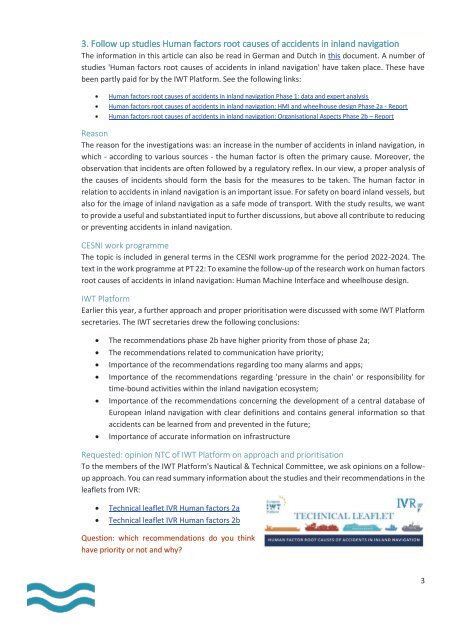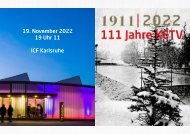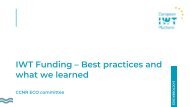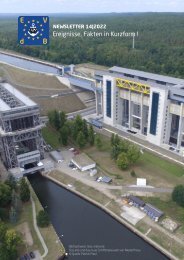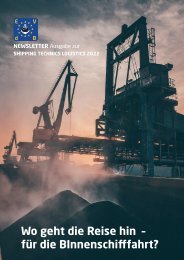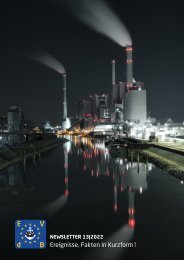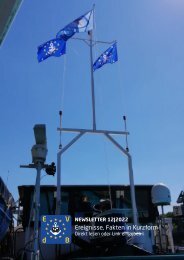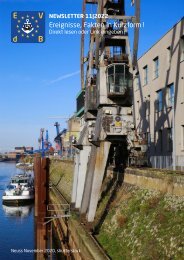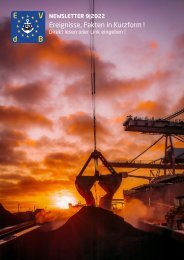EVdB-Newsletter 16-2022
Sie wollen auch ein ePaper? Erhöhen Sie die Reichweite Ihrer Titel.
YUMPU macht aus Druck-PDFs automatisch weboptimierte ePaper, die Google liebt.
3. Follow up studies Human factors root causes of accidents in inland navigation<br />
The information in this article can also be read in German and Dutch in this document. A number of<br />
studies 'Human factors root causes of accidents in inland navigation' have taken place. These have<br />
been partly paid for by the IWT Platform. See the following links:<br />
• Human factors root causes of accidents in inland navigation Phase 1: data and expert analysis<br />
• Human factors root causes of accidents in inland navigation: HMI and wheelhouse design Phase 2a - Report<br />
• Human factors root causes of accidents in inland navigation: Organisational Aspects Phase 2b – Report<br />
Reason<br />
The reason for the investigations was: an increase in the number of accidents in inland navigation, in<br />
which - according to various sources - the human factor is often the primary cause. Moreover, the<br />
observation that incidents are often followed by a regulatory reflex. In our view, a proper analysis of<br />
the causes of incidents should form the basis for the measures to be taken. The human factor in<br />
relation to accidents in inland navigation is an important issue. For safety on board inland vessels, but<br />
also for the image of inland navigation as a safe mode of transport. With the study results, we want<br />
to provide a useful and substantiated input to further discussions, but above all contribute to reducing<br />
or preventing accidents in inland navigation.<br />
CESNI work programme<br />
The topic is included in general terms in the CESNI work programme for the period <strong>2022</strong>-2024. The<br />
text in the work programme at PT 22: To examine the follow-up of the research work on human factors<br />
root causes of accidents in inland navigation: Human Machine Interface and wheelhouse design.<br />
IWT Platform<br />
Earlier this year, a further approach and proper prioritisation were discussed with some IWT Platform<br />
secretaries. The IWT secretaries drew the following conclusions:<br />
• The recommendations phase 2b have higher priority from those of phase 2a;<br />
• The recommendations related to communication have priority;<br />
• Importance of the recommendations regarding too many alarms and apps;<br />
• Importance of the recommendations regarding 'pressure in the chain' or responsibility for<br />
time-bound activities within the inland navigation ecosystem;<br />
• Importance of the recommendations concerning the development of a central database of<br />
European inland navigation with clear definitions and contains general information so that<br />
accidents can be learned from and prevented in the future;<br />
• Importance of accurate information on infrastructure<br />
Requested: opinion NTC of IWT Platform on approach and prioritisation<br />
To the members of the IWT Platform's Nautical & Technical Committee, we ask opinions on a followup<br />
approach. You can read summary information about the studies and their recommendations in the<br />
leaflets from IVR:<br />
• Technical leaflet IVR Human factors 2a<br />
• Technical leaflet IVR Human factors 2b<br />
Question: which recommendations do you think<br />
have priority or not and why?<br />
3


